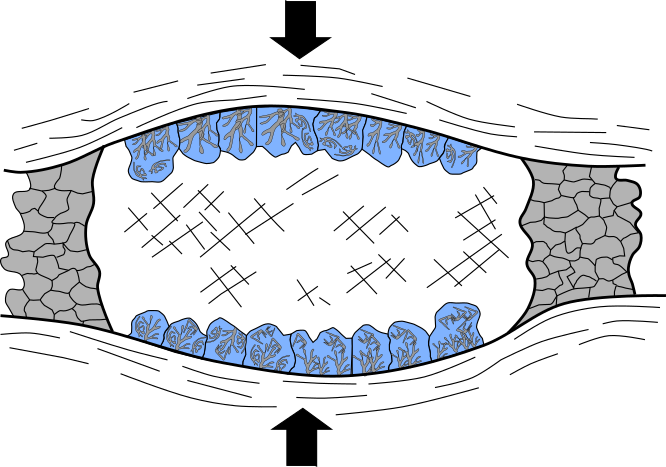Myrmekite
The word myrmekite is derived from the Ancient Greek "myrmekia" (wart) and was used by Jakob Sederholm in 1899 for the first time to describe these structures. Myrmekite is an intergrowth of branching rods of quartz set in a single crystal of plagioclase, neighboring rod of quartz have the same lattice orientation and extinguish together. Myrmekite may also occur at grain boundaries of K-feldspar crystals. Myrmekite occurs ubiquitously both in metamorphic and in granitic rocks, however, the genesis has been an enigma. They provoked a very considerable literature on its origins, but the most accepted hypothesis goes back to Becke (1908) who proposed the reaction of Na- and Ca-bearing fluids with K-feldspar:KAlSi3O8 + Na+ = NaAlSi3O8 + K+
2KAlSi3O8 + Ca2+ = CaAl2Si2O8 + 4SiO2 + 2K+
SiO2 is released because the Al/Si ratio is different in K-feldspar and in Ca-rich feldspar and because of the immobility of Al and Si, quarz forms a microscopic intergrowth with feldspar in quantities that are directly in proportion to the An% of plagioclase.
A second hypothesis that is commonly used to explain the origin of wart like myrmekite is to suggest that the K-feldspar is primary a high-temperature orthoclase, containing dissolved Na and Ca. At low temperatures the orthoclase, under stress, inverts to microcline and supposedly exsolves the Na and Ca to the margin of the crystal to form myrmekite. As above, balanced mass-for-mass equations are used to explain what happens. Because calcic plagioclase requires less silica in its lattice than in K-feldspar or sodic plagioclase, silica is left over to form quartz vermicules in the myrmekite proportional to the Ca-content.
Myrmekite are often associated with strain features in deformed granitic rocks; Simpson & Wintsch (1989) show that they may form only on side of K-Feldspar faciong the shortening direction.

Schematic illustration of K-Feldspar porphyroclast in a deformed rocks, with myrmekite growing on sides facing the shortening direction (black arrows). Modified from David Shelley (1983)
Bibliography
• Cox et al. (1979): The Interpretation of Igneous Rocks, George Allen and Unwin, London.
• Howie, R. A., Zussman, J., & Deer, W. (1992). An introduction to the rock-forming minerals (p. 696). Longman.
• Le Maitre, R. W., Streckeisen, A., Zanettin, B., Le Bas, M. J., Bonin, B., Bateman, P., & Lameyre, J. (2002). Igneous rocks. A classification and glossary of terms, 2. Cambridge University Press.
• Middlemost, E. A. (1986). Magmas and magmatic rocks: an introduction to igneous petrology.
• Shelley, D. (1993). Igneous and metamorphic rocks under the microscope: classification, textures, microstructures and mineral preferred-orientations.
• Vernon, R. H. & Clarke, G. L. (2008): Principles of Metamorphic Petrology. Cambridge University Press.


.jpg)
.jpg)
.jpg)
.jpg)
.jpg)
.jpg)
.jpg)

.jpg)
.jpg)
.jpg)
.jpg)